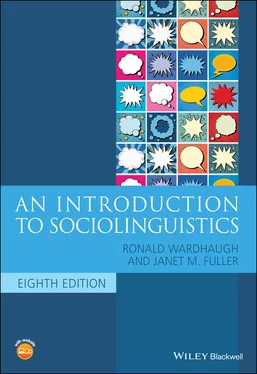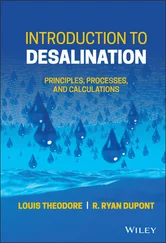Standardizationrefers to the process by which a language has been codified in some way. That process usually involves the development of such things as grammars, spelling books, and dictionaries, and possibly literature (see chapter 13for further discussion of language planning processes). We can often associate specific items or events with standardization, for example, Wycliffe’s and Luther’s translations of the Bible into English and German, respectively, Caxton’s establishment of printing in England, and Dr. Johnson’s dictionary of English published in 1755. Standardization requires that a measure of agreement be achieved about what is considered standard language and what is not.
The standard as an abstraction
We have noted that recent sociolinguistic scholarship challenges the idea of languages as clearly demarcated linguistic systems; the idea that standardized languages cannot be objectively defined has a much longer history. Lippi‐Green (2012) writes about ‘the standard language myth,’ and Crowley (2003) discussed the standard as an ‘idealized language.’ One of the points Lippi‐Green makes is that most people (i.e., non‐linguists) feel strongly that they know what the standard language is ‘much in the same way that most people could draw a unicorn, or describe a being from Star Trek ’s planet Vulcan, or tell us who King Arthur was and why he needed a Round Table’ (Lippi‐Green 2012, 57).
Lippi‐Green also states that we see the standard as a uniform way of speaking; although some regional variation might be allowed (see below for further discussion), social variation is not considered acceptable within anything labeled as the standard. Furthermore, once we have such a codification of the language we tend to see standardization as the end result of a process. Change, therefore, should be resisted since it can only undo what has been done so laboriously. The standardized variety is also often regarded as the natural, proper, and fitting language of those who use – or should use – it. It is part of their heritage and identity, something to be protected, possibly even revered. Milroy (2001, 537) characterizes the resulting ideology as follows: ‘The canonical form of the language is a precious inheritance that has been built up over the generations, not by the millions of native speakers, but by a select few who have lavished loving care upon it, polishing, refining, and enriching it until it has become a fine instrument of expression (often these are thought to be literary figures, such as Shakespeare). This is a view held by people in many walks of life, including plumbers, politicians and professors of literature. It is believed that if the canonical variety is not universally supported and protected, the language will inevitably decline and decay.’
This association with the standard as simultaneously the goal of all and something which is created by (and accessible to) only the educated elite is also noted by Lippi‐Green. She further points out that what is meant by ‘educated’ is never specified; indeed, it is quite circular, as we define the standard as the speech of educated people and educated people as speaking the standard. But the role of the standard in education is quite strong; it is the variety that is taught to both native and non‐native speakers of the language (see chapter 12for more discussion of this).
Exploration 2.2 What is the Standard?
Is there a name for the standardized dialect of your language (or one of the languages you speak)? How is this language defined, and who speaks it, and in what contexts? What are the consequences of not speaking the standardized variety in terms of education, work, and relationships with other members of your community?
The standardization process
In order for a standard form to develop, an idealized norm must be accepted; this is a norm that users of the language are asked to aspire to rather than one that actually accords with their observed behavior. However, it is perceived as a clearly defined variety.
Selection of the norm may prove difficult because choosing one vernacular as a norm means favoring those who speak that variety. As noted by Heller (2010), language can be viewed not as simply a reflection of social order but as something which helps establish social hierarchies. Thus it is not just that a variety is chosen as the model for the standard because it is associated with a prestigious social identity, but that it also enhances the powerful position of those who speak it, while diminishing all other varieties, their users, and any possible competing norms.
The standardization process itself performs a variety of functions. It unifies individuals and groups within a larger community while at the same time separating the community that results from other communities. Therefore, it can be employed to reflect and symbolize some kind of identity: regional, social, ethnic, or religious. A standardized variety can also be used to disenfranchise users of other varieties, usually those who are of lower socioeconomic status or ethnic/racial minorities (Rosa 2016). It can therefore serve as a kind of goal for those who have somewhat different norms; for example, Standard English and Standard French are such goals for many users of nonstandardized dialects of these languages. However, as we will see, these goals are not always pursued and may even be resisted.
The standard and language change
Standardization is an ongoing process, for only ‘dead’ languages (i.e., languages that no longer have native speakers) like Latin and Classical Greek do not continue to change and develop. What is considered standard in living languages continues to change. The standardization process is also obviously one that attempts either to reduce or to eliminate diversity and variety. Given that variation is inherent to language, standardization imposes a strain on languages or, if not on the languages themselves, on those who take on the task of standardization. That may be one of the reasons why various national academies have had so many difficulties in their work: they are essentially in a no‐win situation, always trying to ‘fix’ the consequences of changes that they cannot prevent, and continually being compelled to issue new pronouncements on linguistic matters. Unfortunately, those who think you can standardize and ‘fix’ a language for all time are often quite influential in terms of popular attitudes about language. Opinion articles about how social media and technology are ruining language have addressed alternative spellings and the use of emojis as signs of the demise of sophisticated speech as we know it (see links in the companion website), but technology is not the only culprit named. Young people are identified as the problem in every generation (especially but not only because of their social media language use), and Americanisms are also named as the source of the deterioration of English (see for instance Engel 2017). While these articles focus on vocabulary and orthography, of course there are changes on all levels of language (see discussion of variation in chapter 1).
These articles you can access through links on the companion website focus on the purity of English, but of course the ideal of a pure language is not unique to anglophones. Users of other languages also complain about change – including influence from English, usually in the form of loanwords! We’ll return to the topic of the influence of English on other languages in chapters 10and 13.
Such negative attitudes about language change are not in keeping with how sociolinguists view language; as we have discussed above, internal variation is inherent to all languages, and all languages keep changing. Also, such prescriptivist views are inherently classist and discriminatory against anyone who is not a member of the privileged class; we will develop our ideas about this below in our discussion of the standard language ideology.
Читать дальше




![Andrew Radford - Linguistics An Introduction [Second Edition]](/books/397851/andrew-radford-linguistics-an-introduction-second-thumb.webp)







